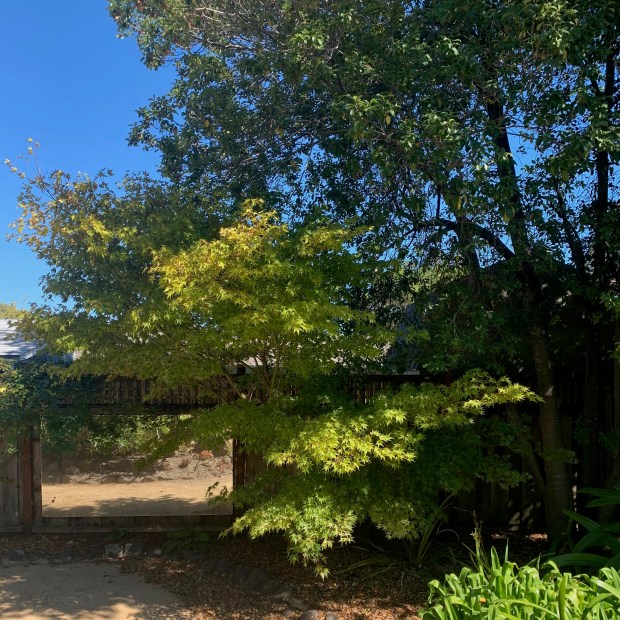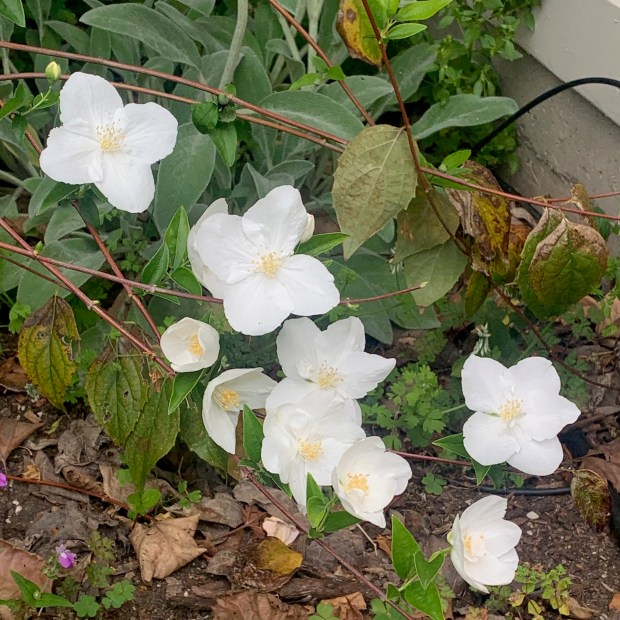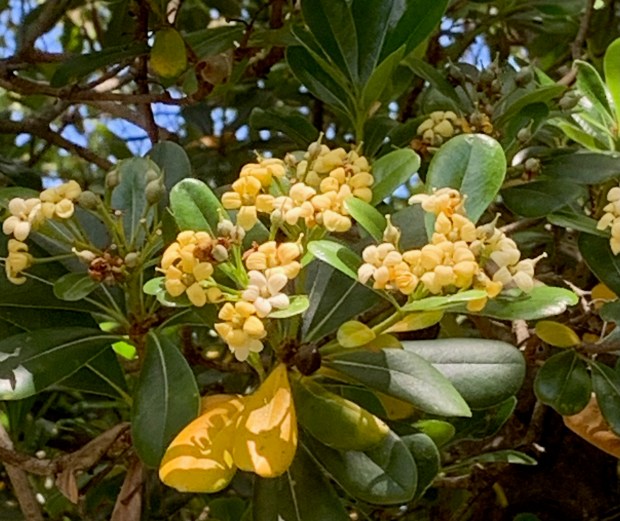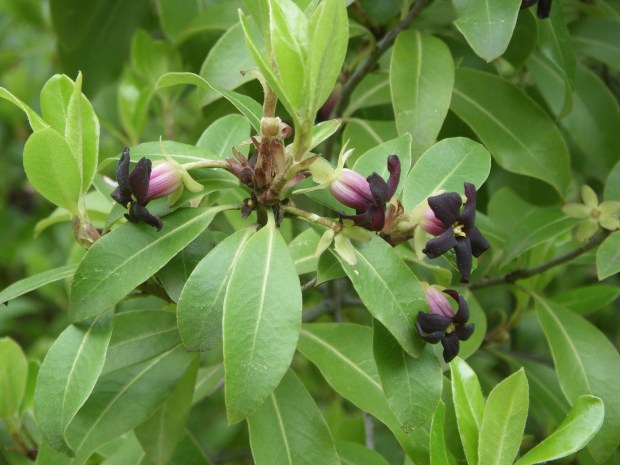Toothed-leaf athanasia (Athanasia dentata). This South African native is a small shrub that grows fast, 3 to 4 feet high, with attractive small green recurving leaves arranged tightly on vertical slender branches. Disks of bright golden yellow flowers appear in flat heads at branch tips. These disks hold 30 to 60 tiny individual florets on several button-like heads that are showy against the green foliage and honey-scented. The generic name comes from Greek words meaning “without death,” referring to the plant’s persistent dryness after flowering. “Dentata” refers to the serrations on the leaves. (Courtesy Tom Karwin)

Japanese maple (Acer palmatum) adjusting to the intrusion of a black matipo (Pittosporum tenuifolium). The mirror in the fence provides small amusement. (Courtesy Tom Karwin)

Mock orange (Philadelphus lewisii). This deciduous shrub, a native of California, displays a profusion of white blossoms from spring to summer. It sends out long stems, which are red when new and fade to gray with age. Its leaves are light green in color with a rough texture, generally turning a lovely yellow in fall. The large flowers bloom in clusters at the ends of long stems and have a heavy, sweet scent reminiscent of citrus blossoms. They are among the most fragrant flowers of any California native plant. Caption edited from Calscape. (Courtesy Tom Karwin)

Japanese cheesewood, mock orange (Pittosporum tobira). This evergreen shrub, native to Japan and China, grows to 30 feet, with white flowers at the end of its branches. It is popular throughout the world as an ornamental plant. The genus name is from Greek words meaning “pitch” and “seed,” referring to a resinous substance around the seeds. The species name is from a Japanese word meaning “door tree.” (Courtesy Jim Evans via Wikimedia Commons)

Black matipo, kohuhu (Pittosporum tenuifolium). This native of New Zealand is an upright, evergreen shrub that grows rapidly, reaching heights of up to 30 feet and widths of 10 feet. Its glossy green leaves are held on nearly black stems and, in spring, it develops dark purple, fragrant flowers in small clusters at the ends of the stems, followed by small orange fruits. The species name is from the Latin words for “slender” and “leaves.” (Courtesy Cillas via Wikimedia Commons)

Rosa ‘Graham Thomas.’ A vigorous, upright climber bearing cupped blooms in an unusually rich shade of yellow. There is a light tea fragrance with hints of violets. It is clothed in attractive, smooth green foliage. The cultivar name honors the British horticulturist who was one of the most influential gardeners of his time. Caption based on davidaustinroses.com. (Courtesy Tom Karwin)
Show Caption
1 of 6
Toothed-leaf athanasia (Athanasia dentata). This South African native is a small shrub that grows fast, 3 to 4 feet high, with attractive small green recurving leaves arranged tightly on vertical slender branches. Disks of bright golden yellow flowers appear in flat heads at branch tips. These disks hold 30 to 60 tiny individual florets on several button-like heads that are showy against the green foliage and honey-scented. The generic name comes from Greek words meaning “without death,” referring to the plant’s persistent dryness after flowering. “Dentata” refers to the serrations on the leaves. (Courtesy Tom Karwin)
Expand
Recently, we encouraged readers to review their gardens periodically to identify both strengths and needs for improvement.
I followed this practice myself, with a gardening friend. We both appreciated the plants, while my friend also checked out the trees and spotted three issues that warranted attention.
Today’s column reviews the discovered needs for tree work and still highlights a few new blooms.
Let’s start with the tree work issues.
Pittosporum issues
Several pittosporum shrubs or trees were in my garden before I acquired the property several decades ago. While we have welcomed them, they are not compatible with our landscape design, which is oriented toward Mediterranean climate zones.
The first issue involves a large pittosporum tenuifolium that has been overshadowing a Japanese maple (Acer palmatum). Cutting the overhanging branches will allow the maple to develop a normal shape. Some trimming of the maple will be needed to balance the form.
Next, near the back fence, we have three adjacent mock orange (Pittosporum tobira) trees, one of which is not thriving and has developed cracks in two trunks. Removing this plant will allow the neighboring tree to assume a normal shape and provide more sunlight for the large rosa mulliganii that rambles along the fence.
The most pressing tree issue addresses an enormous pittosporum growing near the residence. We first noticed a dying branch that had the potential to fall onto a picket fence and decorative trellis gate. Closer examination revealed a large crack in the tree’s primary trunk, and another crack beginning in its secondary trunk.
This tree is about 40 feet high and more than 2 feet in diameter at the base. While it is a prominent feature of the landscape, the cracks could increase, enabling the tree to fall and damage the residence.
This large tree is protected by the city of Santa Cruz’s ordinance, “Preservation of Heritage Trees and Heritage Shrubs” (General Code Chapter 9.56), so removal requires the city’s approval. We submitted a permit application with photographs of the splits, and the city approved an emergency removal permit.
A tree service had planned to trim the dying branch before scheduling the full removal of the tree, but even as I write this column, they adjusted their work plans and will remove the tree today.
Other tree issues
Today’s tree service will include trimming some leafless branches on a California sycamore (Platanus racemosa).
On another day, the tree service will bring a stump grinder to remove the stumps of the mock orange, the enormous pittosporum of an unknown species, and two large gray cotoneaster (C. franchetii) shrubs.
Our gardeners cut down the cotoneasters a few weeks ago to provide more sunlight for a nearby succulent bed. The cotoneasters are native to China, so their removal aligns the landscape with the design emphasis on the Mediterranean climate zones.
Stump grinding work requires Pacific Gas & Electric’s advanced check to ensure that utility lines will not be endangered by the grinder. The service will schedule this work in the near future.
The grinding process will reduce the stumps to at least six inches below grade level. Some roots would remain and eventually rot away. Replanting the area could require avoiding the old roots or digging them out.
Plants in bloom
Our stroll through the garden was a welcome break from watching the tree work, and a time to note some of the current blooms.
This column’s image gallery includes the flowers of selected plants in my garden, for appreciation.
This week in the garden
Again, walk through your garden, welcome the season and make mental notes for the future.
Enjoy your garden!
Tom Karwin is a past president of Friends of the UC Santa Cruz Arboretum and the Monterey Bay Iris Society, a past president and lifetime member of the Monterey Bay Area Cactus and Succulent Society, a Lifetime UC Master Gardener (certified 1999-2009), past board member of the Santa Cruz Hostel Society and active with the Pacific Horticultural Society and other garden-related societies. To view photos from his garden, visit facebook.com/ongardeningcom-566511763375123. To review the archive of recent On Gardening columns, visit santacruzsentinel.com and search “Karwin.” Go to ongardening.com to review columns from 2012-2020 (and soon) from 2025. Send comments or questions by email to gardening@karwin.com.

